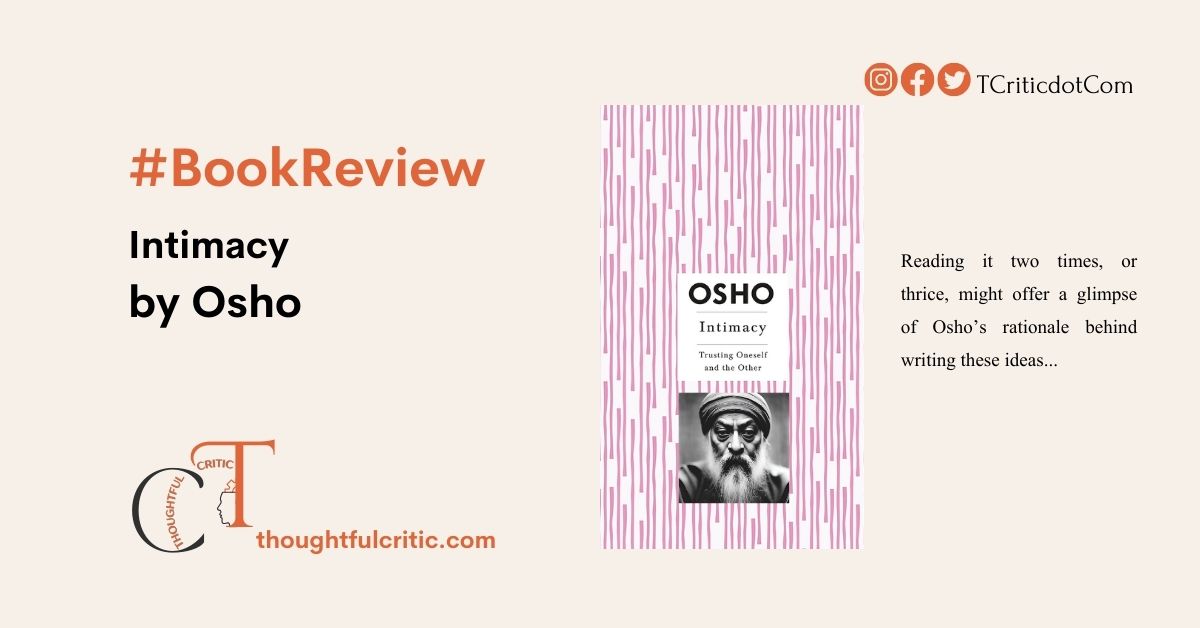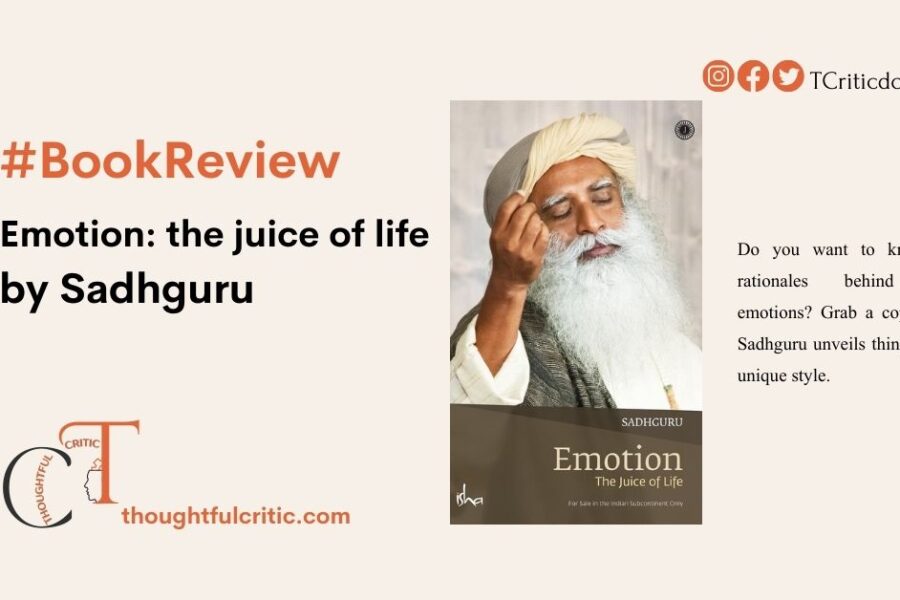“Intimacy: Trusting Oneself and the Other” by Osho contemplates the nature of intimate relationships and the intrinsic human desire for connection. Osho, an Indian mystic and spiritual teacher, is known for his unconventional approach to spirituality and personal development. In this book, he delves into the depths of intimacy, advocating for a profound transformation in how individuals perceive and engage in relationships. The book’s central thesis is that true intimacy can only be achieved through self-awareness and authenticity, shedding societal and psychological barriers that hinder genuine connections.
Osho’s ideas might seem radical. Yet, if you think deeply, he tries to offer something unique. Is that the overdrive (of offering uniqueness) that makes his ideas clumsy? However, Osho’s book is certainly interesting to read. In this article, I will explore Intimacy by Osho and its qualities (and absurdity).
Significant Highlights of the Book:
1. Self-Awareness as a Foundation: Osho emphasises that intimacy starts with knowing oneself. He argues that without self-awareness, individuals project their insecurities and unfulfilled desires onto their partners, which prevents genuine connection.
2. Authenticity and Vulnerability: The book discusses the importance of authenticity and vulnerability in relationships. Osho believes that we can only create deep and meaningful bonds by embracing and revealing our true selves.
3. Breaking Free from Social Conditioning: The book critiques societal norms and expectations that shape our understanding of relationships. Osho asserts that many of these restrictive norms prevent individuals from experiencing true intimacy.
4. Meditative Approach to Relationships: Osho integrates his teachings on meditation, suggesting that a meditative approach to life can enhance intimacy. By being present and fully engaged with one’s partner, individuals can foster a more profound connection.
5. Love vs. Attachment: Osho’s distinction between love and attachment is another critical highlight. He posits that true love is liberating and unconditional, whereas attachment is possessive and often leads to suffering.
Critical Commentary on the Style, Narrative, Structure, and Readability of the Book:
Osho’s narrative style is conversational and reflective, often resembling a series of discourses rather than a structured, linear progression. This style allows for a deep, almost meditative engagement with the text, encouraging readers to ponder and internalise the concepts presented. However, this can also be a double-edged sword; the lack of a clear, organised structure may be challenging for readers accustomed to more traditional formats.
The language is accessible yet profound, blending philosophical insights with practical advice. Osho’s use of anecdotes and parables enriches the narrative, making abstract concepts more relatable. Despite the depth of the subject matter, the book’s readability is relatively high, thanks to Osho’s straightforward and unpretentious language.
Nevertheless, the book’s free-form structure can sometimes feel repetitive. While reinforcing his messages, Osho often reiterates vital points, which might test the patience of readers seeking a more concise exposition. The lack of conventional chapters or sections can also make navigating the book difficult or referencing specific ideas.
Viability of Osho’s Suggestions in the Real World:
Osho’s suggestions for achieving true intimacy through self-awareness, authenticity, and a meditative approach are idealistic yet profoundly challenging. In a world where individuals are often conditioned by societal norms and personal insecurities, implementing these suggestions requires a significant shift in mindset and behaviour.
The viability of these suggestions depends mainly on the individual’s willingness to engage in deep self-reflection and personal growth. For those who are open to exploring and dismantling their psychological barriers, Osho’s teachings can be transformative. However, in practical terms, applying these principles might face resistance due to ingrained habits and external pressures.
Moreover, Osho’s critique of social norms may not be readily embraced by everyone. His call to reject conventional relationship dynamics favouring a more liberated approach can be considered radical. Not all individuals or cultures may be ready to adopt such changes.
Compared to Other Books that Share the Same Themes and Issues:
Osho’s “Intimacy” stands out for its spiritual and philosophical depth compared to other books on intimacy and relationships. While many contemporary books on relationships focus on practical advice and psychological insights, Osho delves into the existential aspects of intimacy. His approach is less about techniques and a fundamental transformation of one’s being.
Books like John Gottman’s “The Seven Principles for Making Marriage Work” or Sue Johnson’s “Hold Me Tight” offer research-based strategies for improving relationships. These works provide tangible tools and methods, whereas Osho’s book invites readers to embark on a more introspective and holistic journey.
Another point of comparison is with spiritual books such as “The Road Less Traveled” by M. Scott Peck, which also integrates psychological and spiritual perspectives. However, Osho’s distinctiveness lies in his unabashed critique of societal norms and his emphasis on meditation as a pathway to deeper connections.
The Ideal Audience for the Book:
The ideal audience for “Intimacy” comprises individuals open to spiritual exploration and willing to question conventional norms. Readers interested in self-development, mindfulness, and meditation will find Osho’s insights particularly resonant. The book is also suitable for those who have experienced challenges in their relationships and are seeking a deeper, more meaningful understanding of intimacy.
However, readers who prefer structured guidance and practical advice might find Osho’s approach too abstract and philosophical. The book best suits those who appreciate a contemplative reading experience and are comfortable with non-linear narratives.
Conclusion:
“Intimacy: Trusting Oneself and the Other” by Osho is a profound exploration of the essence of intimate relationships. Through his emphasis on self-awareness, authenticity, and a meditative approach to life, Osho provides a pathway to deeper, more meaningful connections. While the book’s conversational style and lack of structure may challenge some readers, its spiritual and philosophical depth offers a unique perspective on intimacy.
Though idealistic, Osho’s suggestions can transform one’s approach to relationships if embraced with an open mind and a willingness to change. Compared to other relationship books, Osho’s work stands out for its existential depth and critique of societal norms. The ideal audience for this book includes those who are spiritually inclined and eager to explore the deeper dimensions of intimacy. In conclusion, “Intimacy” is a valuable resource for anyone seeking to understand and experience the true nature of intimate relationships.
Interested in Osho? Here are the articles you will like:
Review by Sidhant for Thoughtful Critic
Intimacy: Trusting Oneself and the Other by Osho Book Review
-
Thoughtful Critic's Rating
Summary
It would be best if you read it. Reread. And read again. Reading once may not yield anything significant in terms of rationale!



